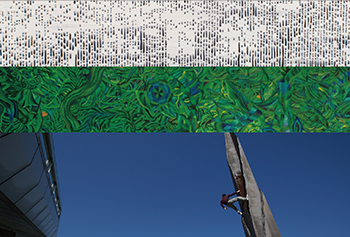 2015 5.29 - 6.27
2015 5.29 - 6.27

"Sensing Body" co-curated
by Daisuke Miyatsu
Installation >>
Opening reception:
5.29 Fri. 18:00 - 20:00
Place: nca | nichido contemporary art
Date:May 29 Friday – June 27 Saturday
Opening hours:Tue – Sat 11:00 – 19:00 (closed on Sun, Mon and National holidays)
Reception:May 29 Friday 18:00 – 20:00
Aritsts:Shinya Imanishi | Ryota Kikuchi | Kazuya Sakamoto
-------------------------------------------------------------------------------------------------------------------------------------------------------------
nca | nichido contemporary art is delighted to announce its group exhibition entitled, “Sensing Body”
From Jackson Pollock (1912 – 1956) in the context of Abstract Expressionism and Yves Klein (1928 – 1962), who was a representative figure in Nouveau Réalisme, to Kazuo Shiraga (1924 – 2008) of the Gutai group, works that attempted to cement a fleeting performative action onto the picture plane have played a major role in many artistic movements.
The diffusion and expansion of social networking sites, internet banking, and e-commerce websites prompted by the advancement of the internet and digital devices in this century, have brought a dramatic change in our lives.
The penetration of virtuality and anonymity of the networked society into the real world was accompanied by our increased interest in our bodies as proofs of our existence. In Japan, the unparalleled disaster of the Great East Japan Earthquake also contributed to the renewed awareness of the importance of the body on which we rely on.
Among the new generation of Japanese artists too, we discern works that focus on physical actions. This exhibition will showcase the works of three artists, Shinya Imanishi, Ryota Kikuchi, and Kazuya Sakamoto, based on the theme of physicality.
Shinya Imanishi creates his paintings by skillfully overlaying layers of oil paints, and repeatedly scraping them off while leaving the traces of the brush strokes. While the details of the materials come to the fore when looking at them at close range, images of degeneration and demise such as a crashed airplane or a fallen camellia emerge into view once the viewer takes some distance. At the same time, these images also evoke themes of regeneration and new beginnings, and express the fact that life and death are always inextricably linked together. They present the ambiguity and uncertainty of the facts and events about which we share a common understanding, while exploring the relationship between material and image, as well as between viewpoint and distance.
Ryota Kikuchi uses his past as a free climber to climb onto public buildings and monuments and create works where his body becomes part of the city’s fabric. Taking advantage of the loophole in the buildings that are constructed with the utmost concern for safety, and by scanning the city with his own body, the artist encourages us to understand the built environment that surrounds us from a different point of view. Kikuchi’s actions of “painting” based on treating the city as a canvas and on looking for places that are suitable for his works, expand the possibilities of graffiti expression, pushing it beyond its conventional boundaries.
Kazuya Sakamoto has consistently painted waterweeds in the past few years. The plants that intricately intertwine in his paintings, combined with the thick application of the paints, cause the viewers to feel as though they are drawn into the water. Born in a place surrounded by lush nature, and growing up feeling the beauty of greenery and water on his skin, Sakamoto describes his choice of depicting waterweeds as a necessity, and as an act to question his own raison d'être. The weeds are meticulously painted and multiply through sheer physical repetition, and they appear to depict the very process of evolution based on the constant alteration to support life. At the same, they also bring to mind the diverse eco system in the globalized contemporary society, in which competitive advantage is formed by the various differences that exist between individuals and groups.
Each brush stroke/action of the above artists represent their intentions while leaving traces that emanate a strong sense of presence. The physicality that become manifest over the picture plane are supplanted by painstakingly calculated compositions and colors, and suggest the great possibilities that the expressions by the new generation harbor.
This project is a new attempt by nca to feature the artistic expressions of a new generation, and was planned in collaboration with collector Daisuke Miyatsu.
-------------------------------------------------------------------------------------------------------------------------------------------------------------
Daisuke Miyatsu (Art collector )
The collection of contemporary artworks he accumulated as a simple company employee ("salaryman"), as well as his house which he built with the contribution of various artists, have extensively been covered by the Japanese and international press or displayed in exhibitions in places such as
Tokyo Opera City's Art Gallery or the Daelim Museum of Contemporary Art in Seoul. In 2011, a great exhibition of his collection was organized at the Taipei Museum of Contemporary Art (MoCA) in Taiwan, and in 2012 the BEXCO convention centre in Busan with the video and visual works.
Miyatsu Daisuke is the author of "Gendai Art wo KaÔ!" (Let's buy contemporary art!), published in Japanese as part of the Shueisha Shinsho Collection, as well as in traditional Chinese, Taiwanese, and Korean. "Gendai Art Keizaigaku" (Contemporary Art Economics), published by Kobunsha is his latest book.